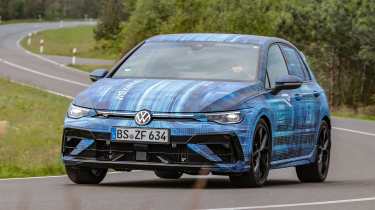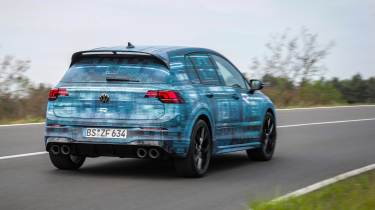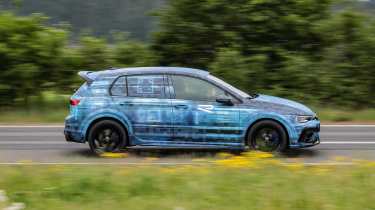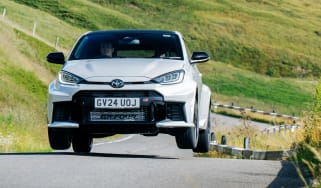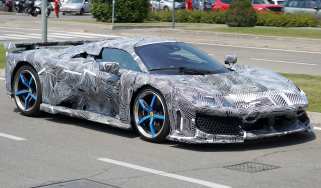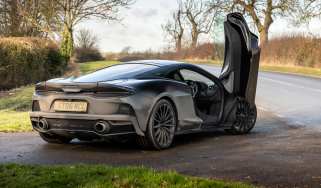Volkswagen Golf R Mk8.5 prototype review – a return to form or another disappointment?
The Mk8 Golf R has never really wowed us, but can the Mk8.5 change that? A drive in a prototype version provides some clues
It’s fair to say that evo’s assessment of the Mk8-generation Volkswagen Golf R hasn’t been entirely positive. It’s a hot hatch we respect rather than adore, one which makes its performance effortlessly accessible but somehow doesn’t deliver the satisfaction of the very best. Compared to Honda’s stunning Civic Type R it lacks feedback, purity, and in broad terms, a sense of purpose. In issue 318 of evo, the Type R won our 18-car hot hatch megatest while the Golf just scraped into the top ten, which tells you most of what you need to know.
But a new day, a new car and a chance to approach the Golf R with a fresh mind. Volkswagen is launching an updated R as part of the Golf’s Mk8.5 facelift, and we flew to Berlin to drive a pre-production example on the road. It’ll be a little while before we see the final car, but it’s clear that the camouflage isn’t hiding any sort of radical redesign, and the signs are that it won’t be much different to drive than the Mk8 either. ‘It was a case of refining a few things, we were very happy with what we had before,’ says Volkswagen R engineer Jonas Thielebein.
As such, pretty much all of the new R’s mechanical hardware is carried over from its predecessor. The MQB platform is unchanged (and shared with the likes of the Audi S3 and Skoda Octavia vRS), so too the seven-speed DSG gearbox and four-wheel drive system. The latter uses a variable torque vectoring differential to apportion power between the rear wheels, with the ability to overdrive the outside rear to rotate the car through corners – or induce bigger angles when using the track-only Drift mode.
More reviews
You won't be surprised to hear that Volkswagen's 2-litre EA888 turbocharged engine continues to serve in the new R, but learnings from the outgoing 20 Years edition have teased a little more power from it. It now offers the same 328bhp as the special edition (peak torque is still 310lb ft), along with that car's revised throttle valve map to hold boost pressure under light loads and improve initial response. The 20 Years also introduced a pronounced gearshift kick when flicking through the DSG ‘box, but the Mk8.5 returns to a smoother calibration.
Climbing into the prototype you drop a few inches lower than normal, enveloped by the reassuring hug of a Recaro Pole Position. These seats completely transform the driving position into something much more purposeful and touring car-like, but we’re told there's no chance of them making production. The half cage behind the seats also hints at what a hardened, stripped-back R could be like, but that too remains a fantasy.
Thumb the starter button and the four-pot motor fires up with the same industrial-sounding gargle we've come to know, but new for the Mk8.5 is a tweaked synthesised engine noise inside the cabin. It’s inoperable in this prototype so we’re left with the raw tunes from the titanium Akrapovic exhaust, which itself has been revised. Also new is the inclusion of an Eco driving mode, and while that may not sound particularly exciting, it has allowed Volkswagen engineers to devise more aggressive powertrain calibrations for Comfort and Sport. As before, there’s also a Race mode and a Nürburgring-developed Special mode, as well as the ability to mix and match settings for the steering, powertrain, DCC dampers and engine sound yourself.
Almost everything about the new car feels familiar. It’s as easy to drive as ever, with calm responses and an engine that builds boost gradually, finding an easy stride as you dip in and out of the throttle. As before, the R is at its best after a few changes in the drive mode menu – that means ramping the drivetrain up to Race, leaving the dampers in Comfort and choosing the lightest mode for the steering (the weight build up is excessive otherwise, particularly in Race). Now you start to feel the extra bite from the engine; the boost gauge holds higher pressures more consistently and there’s more snap to the throttle, which does give the R a more ‘switched on’ feel. Push past this, use the revs and it’s hard to detect the new car’s 12bhp advantage, but the R has real guts right up to autobahn speeds. The manual gear changes are much crisper when you put more energy through the drivetrain, too.
Turning off the motorway and onto Germany’s smooth A-roads is the first chance to feel the R loaded up, and sure enough, it feels almost exactly like its predecessor. You can lean hard into the grip from the Bridgestone Potenzas but there’s the same sense of mass as before, a reluctance to carve to the inside of a corner with the tenacity of a Civic Type R. The steering is fuzzier too, particularly when the front axle skips and thumps over harsh imperfections in the road. The ride is otherwise civilised and compliant with the dampers wound back, and the huge range of the DCC system gives you the ability to significantly tighten their responses. When the surface allows, that is. There’s extra support in Race but the car can skip over sudden bumps that find the limits of the dampers.
The Golf R’s defining dynamic tool is still the torque vectoring rear diff, which gives you freedom to shift the balance around with the throttle. When the front tyres start to scrub your natural reaction is to back off, but being more aggressive with the throttle is more effective in neutralising the car, and allows you to exit on an uninterrupted flow of power. Other times, though, the diff can confuse your internal gyros as it rotates the car at an unnatural rate, making it hard to read the limits and feel connected to the rear end. It’s a complaint we had with the outgoing car, and though the diff has been recalibrated for the Mk8.5, the changes are primarily designed to improve its performance on mixed wet/dry surfaces.
The Mk8.5 is very much an incremental upgrade then, and it’s one that you’d only appreciate having spent time in the Mk8 – subject to what’s new for its (as yet unrevealed) design and interior. From this initial drive, we can’t help but wish that Volkswagen went a little further.
Volkswagen Golf R Mk8.5 specs
| Engine | 4cyl, 1984cc, turbocharged |
Power | 328bhp |
| Torque | 310lb ft |
| Weight | 1555kg (est) |
| Power-to-weight | 211bhp/ton (est) |
| Tyres as tested | Bridgestone Potenza |
| 0-62mph | 4.6sec |
| Top speed | 167mph |
| Basic price | c£45,000 (TBC) |

